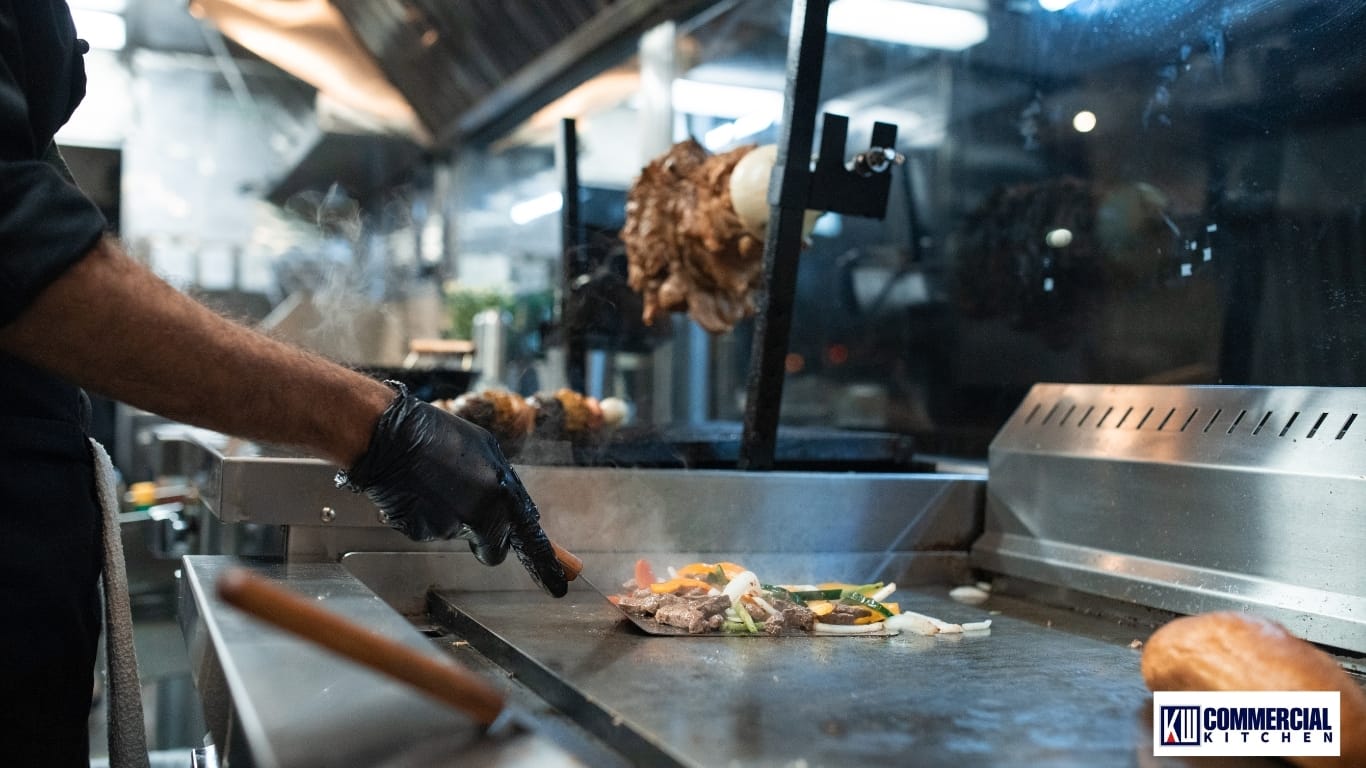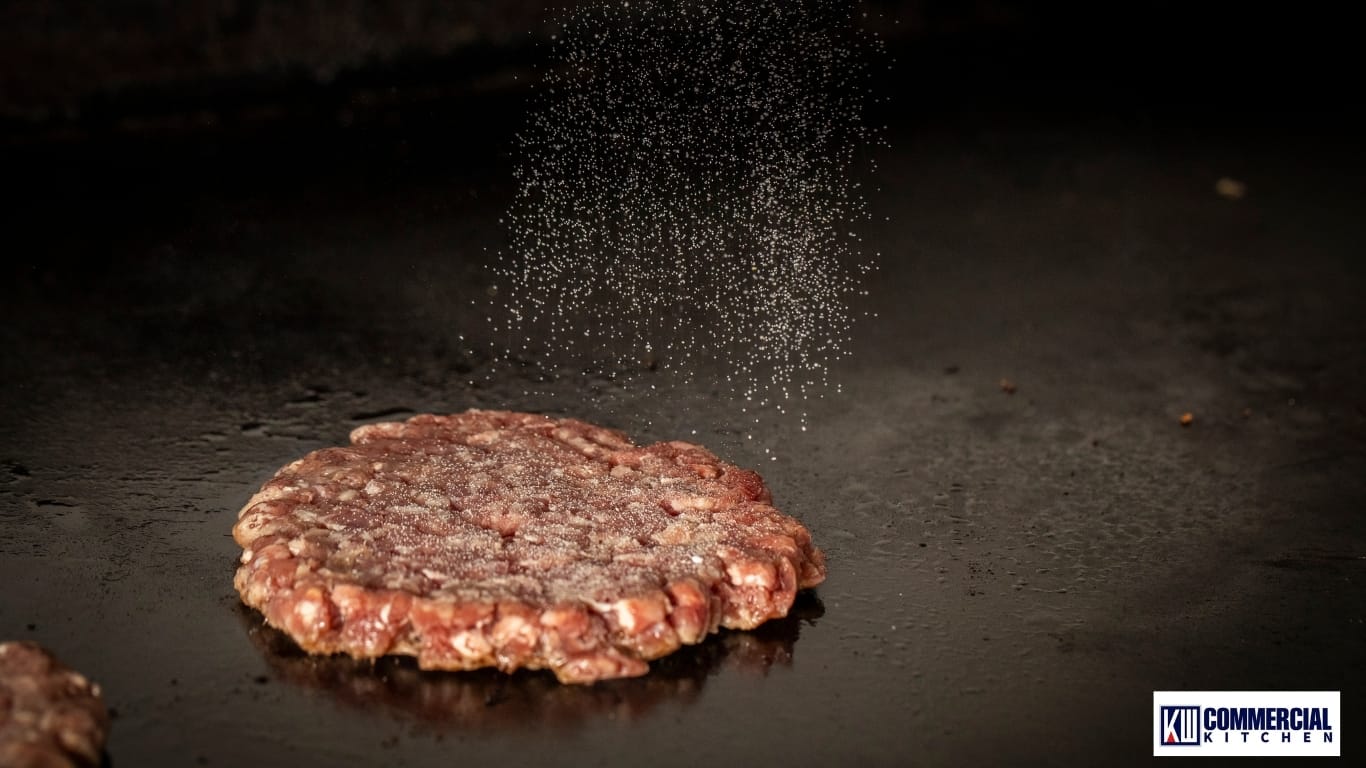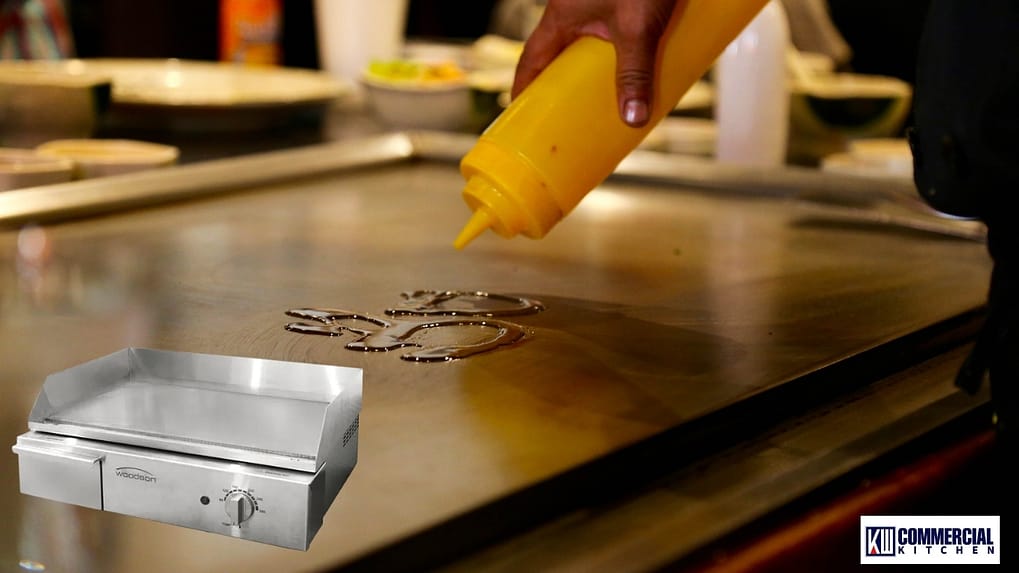Commercial Cooking · Australia · 2025
Commercial Griddle Masterclass (Australia, 2025): What a Griddle Is, How to Cook, Gas vs Electric, Plate Thickness, Cleaning, Ducted vs Ductless & ROI
This is a practical, no‑nonsense field guide to the griddle (a.k.a. flat‑top) for Australian kitchens. You’ll learn exactly what a commercial griddle does, how to light it, how to cook without sticking, how to clean it daily with chemist supplies to meet Council expectations, how to choose between a gas griddle and an electric griddle, when you need a ducted canopy, and how to model real‑world ROI. The aim is smooth installs, smooth service, and zero‑stress inspections.
1) What a griddle is (and isn’t)
A griddle is a thick, heated steel plate that cooks directly on its surface. It’s not a chargrill (no open bars, no flame stripes) and not a pan. The value of a commercial griddle is surface area + plate mass: multiple tickets can cook in parallel, and the plate’s thermal mass keeps temperature stable when cold food hits.
Core parts
- Plate: mild steel, typically 12–25 mm thick; some with hard‑chrome finish.
- Heat: gas burners (rated in MJ/h) or electric elements (kW), split into zones.
- Controls: manual gas valves or thermostats (gas/electric), 2–4 zones by width.
- Chassis: splashback, grease drawer, optional open base or stand.
Why kitchens rely on it
- Even browning via direct conduction (Maillard reaction).
- Repeatable timing during brunch/burger peaks.
- Fast changeovers with a scrape, wipe, oil.
- Lower learning curve than juggling multiple pans.
2) What to cook: menus, cloches, temperatures
Breakfast & brunch
- Eggs (fried/scrambled), pancakes, French toast, bacon, hash browns, haloumi.
- Grilled mushrooms, tomatoes, breakfast wraps, quesadillas.
Typical temps
- Eggs: 160–175 °C (thermostat stable, light oil film)
- Pancakes/French toast: 175–190 °C
- Bacon/hash: 185–205 °C
Burgers, sandwiches & seafood
- Smash burgers: hot centre zone, quick cloche for melt.
- Steak/chicken sandwiches, patty melts, cheesesteaks.
- Flat fish, calamari, prawn skewers on medium‑hot zones.
Typical temps
- Smash patties: 205–230 °C (sear + cloche)
- Fish fillets: 180–200 °C (dry surface + thin oil film)
- Buns/toast: 150–165 °C
3) Start‑up 101: lighting gas, starting electric, preheat discipline
Gas griddle — pilot & main burners
- Open the isolation valve. Confirm gas supply (bottle level or meter on).
- Set controls to OFF. Wait 2–3 minutes to clear any residual gas.
- Press and hold the pilot knob; spark with piezo or an approved igniter.
- Keep holding 30–60 seconds to heat the thermocouple; release. Pilot should stay lit.
- Turn main burners to low; step up gradually. Preheat 15–25 minutes to stabilise the plate.
If pilot won’t hold: check draft/make‑up air, thermocouple seating, or cylinder pressure. Tag‑out and call a licensed gasfitter if in doubt.
Electric griddle — thermostat & staging
- Verify correct supply/phase and breaker is on.
- Set each zone to your target (e.g., 180–190 °C for breakfast).
- Preheat 15–25 minutes until indicator cycles (stable temp).
- Lightly oil and season (see re‑season steps below) before first service.
Don’t “ice shock” a hot plate — it warps and strips seasoning.

4) No‑stick playbook: eggs, fish & seafood without tears
| Item | Why it sticks | Fix (do this) | Don’t do this |
|---|---|---|---|
| Eggs | Plate too hot or unseasoned; dry surface; old carbon | Run 160–175 °C, wipe a thin oil film, crack into a small oil patch, gentle offset spatula | Overheat the zone; scrub with caustic then cook immediately (re‑season first) |
| Fish fillets | Wet surface; moving too early; bare plate | Pat very dry, oil the fish (not the plate), don’t move until proteins set, flip once | Drag a thin spatula under half‑set protein |
| Calamari/prawns | Syrupy marinades; sugar burns | Blot marinades; use medium‑hot zone; finish under cloche if needed | Cook in a puddle of sweet marinade on high heat |
| Smash burgers | Grey ring from temp sag; meat water | Heavier plate or hotter centre zone; smash once; scrape with firm straight edge; cloche to finish | Flip repeatedly; flood oil under the patty |
KW insight: Most sticking is temperature discipline + dry surface + thin oil film + patience. If it still sticks, fix the seasoning and cleaning routine first.
5) Daily cleaning with “chemist” supplies (Council‑ready)
“Chemist” here means your commercial chemical supplier or food‑safe products you can buy from a reputable chemist store. Aim for non‑caustic, food‑contact‑safe degreasers for mild steel plates and a separate sanitiser for adjacent surfaces. Councils expect clean plates, clean surrounds, labelled chemicals, correct dilution, and safe storage (SDS available on site).
| Step | What to use | Why |
|---|---|---|
| 1. Scrape while warm | Stainless scraper; for mild steel a fine griddle stone if needed | Removes food/carbon without gouging. No stones on chrome plates. |
| 2. De‑glaze (optional) | Small splash of warm water or ice‑free sizzle, then wipe | Steam loosens residue; avoid thermal shock. |
| 3. Degrease lightly | Non‑caustic food‑safe degreaser (follow label, e.g., 1–2%) | Breaks film; caustic strippers remove seasoning and pit steel. |
| 4. Rinse & dry | Potable water, clean cloth | Removes chemical residue; prevents off‑flavours. |
| 5. Re‑oil to protect | High‑smoke‑point oil (canola/grapeseed) | Thin film prevents rust and maintains seasoning. |
| 6. Surrounds & handles | Food‑surface sanitiser (quats or peracetic, per label) | Council expects benches, splashbacks, knobs and handles sanitised. |
| 7. Grease drawer | Empty, hot water + detergent; dry fully | Prevents rancid odours and pest attraction. |
Chemical quick‑reference
- Degreaser: non‑caustic, food‑safe. Typical dilution 1–2% (check label).
- Sanitiser: quaternary ammonium (quats) or peracetic acid. Follow label contact time; avoid chlorine on bare mild steel (corrosion risk).
- Do not use: caustic oven cleaner, harsh abrasives on chrome plates.
Council expectations (practical)
- Labelled spray bottles with dilution ratios; SDS on site.
- Colour‑coded cloths; separate for food‑contact vs general.
- Daily cleaning log (plate & surrounds) signed by shift lead.
- Food‑safe storage: chemicals in a dedicated cupboard, never above food prep.
6) Weekly deep‑clean, re‑seasoning & plate protection
Deep‑clean (mild steel)
- Warm plate to low‑medium. Scrape thoroughly.
- Apply non‑caustic degreaser; agitate with pad; rinse with potable water.
- Heat to drive off moisture; wipe dry.
- Wipe a very thin oil layer; heat until light smoke; cool; repeat 2–3 times to re‑season.
Chrome plates
- No stones, no pumice, no caustic. Use approved chrome cleaner and soft cloth.
- Rinse and dry; never leave acidic residues.
Protect the plate
- Avoid acidic marinades directly on bare plate; use a light oil base first.
- Don’t salt the plate; salt food, not steel.
- Never quench with ice — warping risk.
7) Ducted vs ductless: what’s allowed for gas & electric
In Australia, commercial cooking that generates heat, smoke and grease‑laden vapours is generally expected to be exhausted to the outside via a ducted mechanical canopy. This applies to both gas griddles and most electric griddles. “Ductless/ventless” filtration units may be considered only in specific, low‑risk cases (usually electric, with certified multi‑stage filtration) and only with written approval from the local authority.
8) Gas griddle vs electric griddle: picking the platform
| Factor | Gas griddle (NG/LPG) | Electric griddle |
|---|---|---|
| Typical 900 mm input | ~60–90 MJ/h (≈ 17–25 kW thermal) | ~9–15 kW (3‑phase typical) |
| Control feel | Manual or thermostatic; fast sear response | Thermostatic; very stable for eggs/fish |
| Warm‑up | Fast; depends on plate mass | Fast‑to‑moderate; excellent stability once hot |
| Install | Licensed gasfitter; ducted canopy; bottle logistics for LPG | Electrical capacity (amps/kVA); usually ducted canopy |
| Best fit | High‑output burgers, pubs, trucks (LPG) | All‑electric shells; hotels; mixed menus |

9) Plate thickness & sizing (12–25 mm, 12″–48″)
| Width | Typical plate (W×D) | Realistic slots/cycle* | Use‑case | Plate thickness |
|---|---|---|---|---|
| 12″ / 305 mm | ~305 × 500–550 mm | ~6–7 | Add‑on egg/bacon; trucks | 12–16 mm |
| 24″ / 609 mm | ~609 × 500–550 mm | ~12–15 | Brunch cafés ≤ ~60 covers/h | 16–20 mm |
| 36″ / 914 mm | ~914 × 500–550 mm | ~18–22 | Burger/Brunch peaks with two cooks | 18–25 mm |
| 48″ / 1219 mm | ~1219 × 500–550 mm | ~25–30 | Dual station, events, FOH show | 20–25 mm |
*Assumes ~115 × 115 mm footprint and 50–60% occupancy. Adjust to your menu cycle time.
Rule of thumb: upgrade plate thickness before chasing more burner input — mass stabilises temp and reduces the “grey ring”.
10) Energy math & ROI you can defend
| Scenario | Formula | Example | Result |
|---|---|---|---|
| Gas hourly cost (NG) | Cost/h = (MJ/h × duty) ÷ 1000 × $/GJ | 63 × 0.6 ÷ 1000 × $12 | ≈ $0.45 / h |
| Gas hourly cost (LPG) | Cost/h = (MJ/h × duty) ÷ 1000 × $/GJ | 63 × 0.5 ÷ 1000 × $60 | ≈ $1.89 / h |
| Electric hourly cost | Cost/h = (kW × duty) × $/kWh | 12 × 0.5 × $0.30 | = $1.80 / h |
| MJ ↔ kW | kW = MJ/h × 0.2778 | 63 MJ/h | ≈ 17.5 kW thermal |
| LPG bottle runtime | Hours ≈ Bottle MJ ÷ (MJ/h × duty) | ~2200 ÷ (63 × 0.6) | ≈ 58 h per 45 kg |
ROI that actually matters
- Throughput: extra items per peak hour drive revenue.
- Labour minutes saved: shorter ticket times and fewer remakes.
- Energy: smaller effect vs throughput, but easy to quantify.
| Line | Formula | Example |
|---|---|---|
| Δ items/day | (New slots − Old) × cycles | (20 − 13) × 6 = 42 |
| GM gain/day | Δ items × margin | 42 × $12 = $504 |
| Labour saved/day | mins × wage/min | 120 × $0.58 ≈ $70 |
| Payback | Capex ÷ (GM + Labour − ΔEnergy) | $6,500 ÷ ~$574 ≈ ~11 days |
11) Troubleshooting & emergency actions
| Symptom | Likely cause | Immediate fix | Longer‑term fix |
|---|---|---|---|
| Pilot won’t stay lit (gas) | Draft/no make‑up air; cold thermocouple; low gas | Close doors causing drafts; hold pilot longer; check bottle | Service thermocouple/pilot; verify air supply; check regulator |
| Uneven heat map | Carbon build‑up, warped plate, poor zoning | Scrape, de‑glaze, reset zones | Deep‑clean; re‑season; review plate thickness |
| Everything sticks | No seasoning; too hot; wet product | Thin oil film; drop temp; pat food dry | Weekly re‑season; staff training on temps/patience |
| Smoke in dining room | Under‑capture; no make‑up air; filters blocked | Reduce load; check filters; open make‑up path | Resize canopy/capture; schedule filter cleaning |
| Rust patches overnight | Left wet; no oil film | Lightly abrade; re‑season | Enforce close routine: dry + thin oil film |
Emergency: you smell gas
- Isolate the gas immediately (valve off). Don’t operate electrical switches.
- Open doors/windows; evacuate staff and patrons if strong.
- Do not relight. Call your licensed gasfitter/provider. Tag‑out the appliance.
- Record the incident and corrective actions for your food safety file.
12) One‑page buying checklist (KW quick wins)
Define the job
- Menu & peak covers/h (breakfast, burgers, mixed).
- Who runs the plate (lead cook vs rotating crew).
- Space for 24″/36″/48″ and grease drawer access.
Pick the platform
- Gas griddle (NG/LPG) vs electric griddle (3‑phase).
- Controls: thermostatic for repeatability; manual for sear‑forward lines.
- Target plate: 18–20 mm general; 25 mm for heavy smash peaks.
Engineer the install
- Confirm input (MJ/h or kW) and site capacity (gas/electrical).
- Assume ducted canopy by default; only pursue ductless for eligible electric cases with Council approval.
- Plan make‑up air, filter access, splash guards, cloche storage.
Lock ROI
- Run the energy formulas with your actual tariffs.
- Model throughput/labour saving at the bottleneck hour.
- Set a payback window (6–12 months) and choose plate accordingly.
13) FAQ
What’s the one‑line definition of a griddle?
A griddle is a thick, heated steel plate that cooks food directly on its surface for even browning and high throughput.
Gas or electric — which is cheaper to run?
Use the formulas above with your tariffs. Pipeline gas often costs less per unit of heat than LPG; electric depends on kWh rate and demand charges. Throughput usually drives ROI more than energy alone.
Can I use a ductless hood with an electric griddle?
Only sometimes, and only with explicit written approval. The default expectation is a ducted canopy for both gas and electric griddles because of grease‑laden vapours.
What chemicals are safe for daily cleaning?
Use non‑caustic, food‑safe degreaser on mild steel plates and a separate food‑surface sanitiser for surrounds. Avoid caustic oven cleaner and abrasives on chrome plates.
How do I stop eggs/fish from sticking?
Correct temperature, dry product, a thin oil film, and patience. Re‑season weekly if needed.

